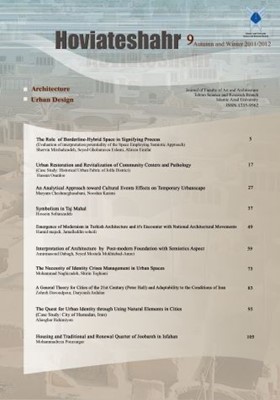A General Theory for Cities of the 21st Century (Peter Hall) and Adaptability to the Conditions of Iran
Subject Areas : architectureZohreh Davoudpour 1 , Daryoush Ardalan 2
1 - Assistant Professor, Qazvin Branch, Islamic Azad University, Qazvin, Iran.
2 - , M.A. in urban and Regional planning, Gazvin branch, Islamic Azad University
Keywords:
Abstract :
In recent decades, there are some new approaches to city and urban problems. Now these days, urban planners review the mutations of different cities. They want to achieve the realistic patterns by recognizing their evolution. Certainly, different factors (The contributing forces such as globalization, technological development, the informational economy, new industries, transportation and communication, environmental politics, competition among places, etc.) influence all the cities. Their evolutions are not similar together. This subject shows, offering the realistic recommendation is complex. Peter Hall studied many cities in the world near the end of 20th century, until recognizes and compares them, to achieve the suitable pattern. He said, a set of forces – economic, technological, social–are operating together, to influence profoundly the global system of cities. These changes express themselves both in the relationship of individual cities to each other and to the system of which they form a part; and also in the internal structure of these cities. First, He seeks to summary the nature and effect of the forces; and then to speculate on the resulting changes to the urban system. To understand how these changes impinge on the urban system, he needs a different taxonomy from the one we have inherited from Christaller and Losch. He can distinguish at least two significant levels of a global hierarchy, though with considerable doubt as to where many cities belong, as well as a number of other categories that has significant relations to these two. Global cities: These are cities that transact a substantial pan: of their business at a global scale, both with other global cities and with lower-order cities. This global business consists mainly in performance of specialized services. such as financial services, media services, educational and health services, and tourism (including business tourism).They are invariably seats of central banks, major clusters of clearing banks (including substantial representation of overseas banks),stock exchanges, insurance companies, headquarters of major corporations (including transnational),television stations, newspapers and magazines, publishers, major universities and hospitals, and leading international airports. However, following the Christaller scheme, they also perform lower-order functions for more restricted areas. The most important of these is the national level; London, Paris, Brussels, Amsterdam and Milan are a global city. National and regional cities : At the next level of the hierarchy it is therefore necessary to consider a complex phenomenon, since the European national capital cities immediately below the global level (Bonn, Amsterdam, Madrid, Rome, Copenhagen, Stockholm, Oslo, Vienna) can only be compared with major regional cities in the US and Japan. In particular, nations with a federal structure or a history of late union, or both (Spain, Italy, Germany, the US, Mexico, Brazil) tend to have a small number of very important provincial cities which not only challenge their national capitals, splitting functions with them and effectively serving as regional capitals for wide areas. Three kinds of activities showed themselves particularly prone to relocation. This research, primarily debates upon Peter Hall's theory, then compares middle and large cities in Iran with its results.
_||_


